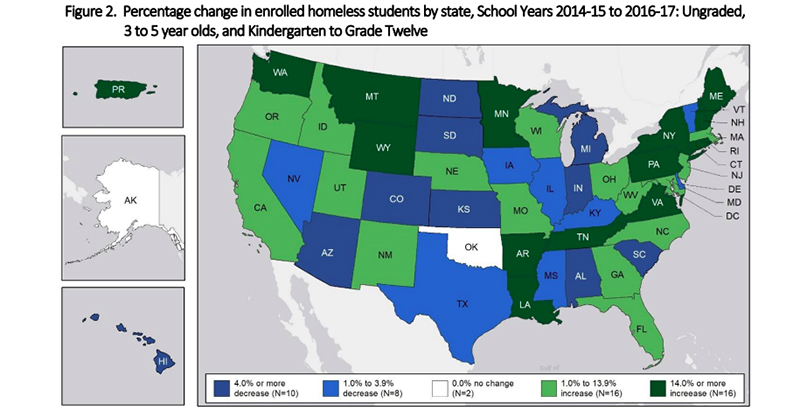1.3 Million Homeless Students: New Federal Data Show a 70 Percent Jump in K-12 Homelessness Over Past Decade, With Big Implications for Academic Performance

This is the latest article in The 74’s ongoing ‘Big Picture’ series, bringing American education into sharper focus through new research and data. Go Deeper: Get our newest numbers and our latest coverage of America’s 74 million children delivered straight to your inbox by signing up for The 74 Newsletter
Student homelessness has hit an all-time high following a significant spike over the past three years, with 20 states experiencing a surge of 10 percent or more, new federal data released last week indicate. The data also found that students who experience homelessness are significantly less likely to graduate from high school.
More than 1.3 million public school students experienced homelessness during the 2016-17 school year, a 7 percent increase over three years ago and the largest number ever recorded. Over the past decade, the population of students experiencing homelessness has spiked by a startling 70 percent.
Several factors might have contributed to the growth in student homelessness. Among them are lingering effects of the recession, local economic issues, natural disasters, and the opioid epidemic, said Barbara Duffield, executive director of the nonprofit SchoolHouse Connection, which works to address homelessness through education.
“Homelessness is complex is the bottom line. Lots of different things go into it, and so there are both economic issues and issues around addiction and mental health challenges and domestic violence,” she said.
But the larger numbers, she cautioned, could be due in part to better identification. An increase from better tracking could be positive, Duffield said, “because we have to know who they are in order to help.”
“These children don’t announce themselves,” she said. “They don’t come up and say ‘Hi, I’m homeless, help me.’”
Under the federal McKinney-Vento Homeless Assistance Act, children are considered homeless if they lack a fixed, regular, and adequate nighttime residence. That includes children who reside in shelters, cars, or campgrounds because they lack alternatives. It also includes families who double up with others due to economic hardship or loss of housing. Doubling up accounted for 76 percent of student homelessness in 2016-17.
Meanwhile, 14 percent of homeless youth resided in shelters, 6 percent lived in hotels or motels, and 4 percent were identified as unsheltered. The unsheltered category saw the most growth, increasing by 27 percent over the three-year period.
Homelessness has significant academic ramifications. Utilizing data from 44 states, the report shows that students who experienced homelessness during the 2016-17 school year had a graduation rate of 64 percent — compared with a 77.6 percent graduation rate among other low-income students, and a national average of 84.1 percent.
Among students who experienced homelessness in 2016-17, about 30 percent were proficient in reading and 25 percent were proficient in mathematics.
When the Education Department releases data on the 2017-18 school year, it will include graduation data from all states, as required by the federal Every Student Succeeds Act. That new data, Duffield said, will provide “a better understanding that students who experience homelessness have challenges over and above simply being poor.”
“There’s this misperception that homelessness is just a poor child without a house temporarily,” she said. “But there’s a lot more that goes with it.”
If they’re interested in improving graduation rates for all students, schools need to hone in on the performance of homeless students, Duffield said.
Coinciding with the new federal data, a separate report offering a snapshot of student homelessness across the 50 states was released by the Education Leads Home campaign, a partnership between SchoolHouse Connection, Civic, America’s Promise Alliance, and the Institute for Children, Poverty, and Homelessness. The report includes state-level data on student homelessness, showing that New York has the highest rate of student homelessness nationally.
The campaign, which aims to improve the graduation rates of homeless students, notes that children without stable living conditions are 87 percent more likely to drop out of school and, without a diploma, more than four times as likely to become homeless as young adults.
Duffield said she’s worried that the growth in student homelessness “reflects communities not understanding the needs of families and youth, and not really stepping up when it comes to providing shelter and services.”
Go Deeper: This is the latest article in The 74’s ongoing ‘Big Picture’ series, bringing American education into sharper focus through coverage of the latest data and research. Get new additions delivered straight to your inbox by signing up for The 74 Newsletter; here are a few notable recent dispatches:
- Student Engagement: Bored in class — A national survey finds nearly 1 in 3 teens are bored ‘most or all of the time’ in school, and a majority report high levels of stress
- School Choice: New Florida study shows students using state’s tax credit scholarship program more likely to attend and graduate college
- Academics: Is homework too easy? With half of parents expressing concerns, new study says students’ assignments lack rigor, favor lower-level skills
- Trauma: Despite prevalent trauma, from school shootings to the opioid epidemic, few states have policies to fully address student needs, study finds
Get stories like these delivered straight to your inbox. Sign up for The 74 Newsletter

;)
